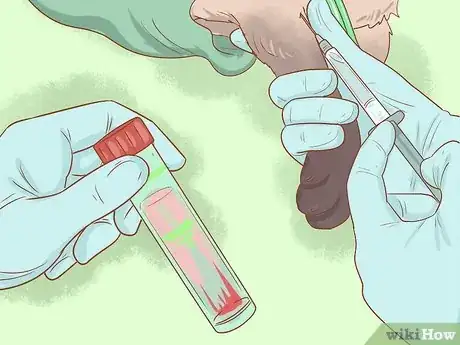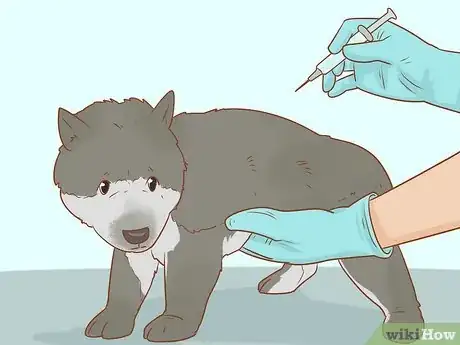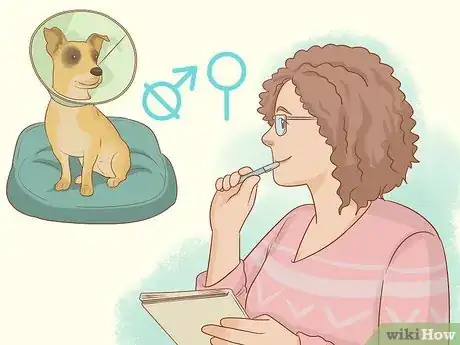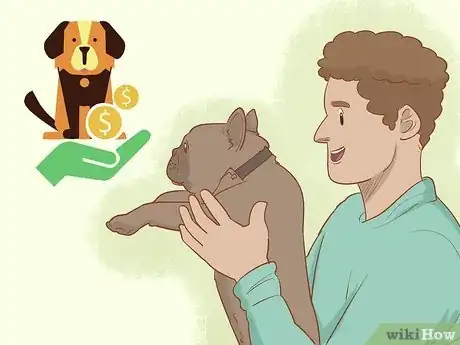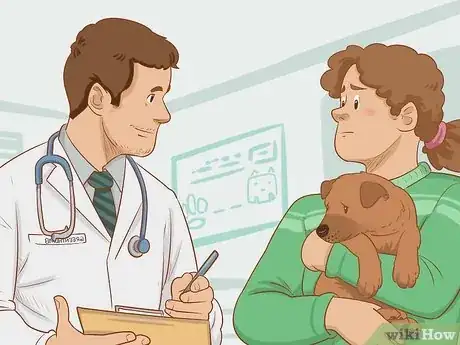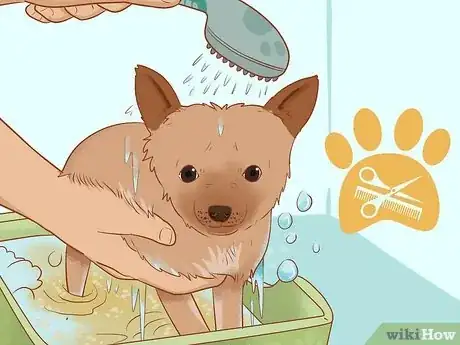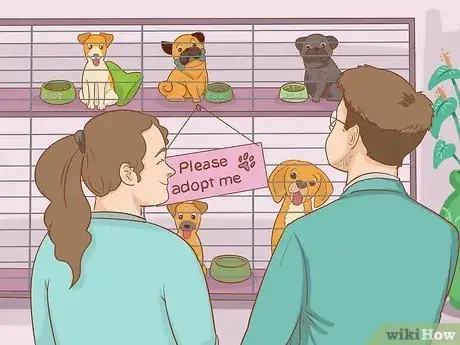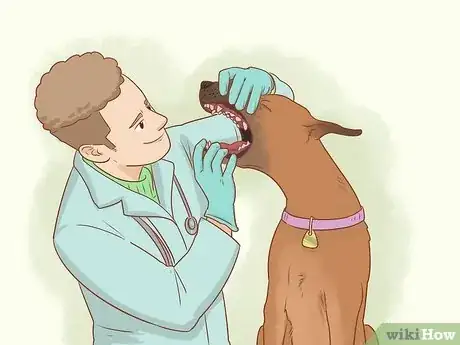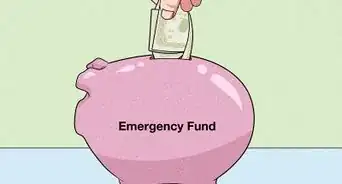This article was co-authored by Belgin Altundag and by wikiHow staff writer, Aly Rusciano. Belgin Altundag is a Certified Dog Trainer and the Owner of Happy Doggies Day Care/Day Camp in West Hollywood, California. A passionate animal lover, Belgin is knowledgeable about multiple training styles, including obedience training, problem-solving, activity training, and behavior modification. In addition to being an Animal Behavior College’s Certified Dog Trainer (ABCDT), Belgin has also completed the Training Cesar's Way Fundamentals of Dog Behavior and Training Programs 1 and 2 and is certified by the American Red Cross in Cat and Dog First-Aid.
There are 11 references cited in this article, which can be found at the bottom of the page.
This article has been viewed 1,093 times.
You can’t wait to play fetch and take walks with your new furry friend, but have you thought about how much a dog can cost? Adopting a dog is no small feat—after all, you’re bringing a new family member home. Before you sign those papers, it’s best to think ahead and be financially prepared to give your adopted pup the very best life. We’ll teach you everything you need to know about calculating estimated prices and expenses, so you can enjoy the fun part: playing with your new dog!
Steps
How to Calculate the Cost of a Dog
-
1Have an idea of what type of dog you’d like to adopt. We know going to the shelter and connecting with a doggo is a big part of the adoption process. Still, there’s no harm in thinking about what dog would best fit your lifestyle. Are you looking to adopt a big dog? Tiny dog? Puppy? Elder? These questions can help you when calculating your adoption and dog budget.
- Puppies tend to cost more at shelters because they’re in high demand.
- Older and smaller dogs may require more veterinary care and medications.
- Larger dogs will go through a bag of kibble faster than a smaller dogs.
-
2Make a list of what you need. If this is your first time adopting a dog, you’ll need all the initial supplies like a collar, toys, dog bed, you name it. On this list, write out the price of each item. This will help you understand how much you’ll have to pay upfront. Your list might look similar to this:
- Collar: $20
- Dog bed: $108
- Crate: $48
- Toys: $25
-
3Estimate the cost of medical care. It’s always best to find your veterinarian or clinic before adopting a pet. Do some research and give the vet you’re eyeing a call. Your pup will need to visit the vet at least every year for a check-up and a yearly supply of heartworm and flea/tick medication.
-
4Take your lifestyle into consideration. Will you be walking your dog yourself or hiring a dog walker? Will you need to board your pup when away on a business trip? Does your apartment complex have a pet fee? These are important questions to ask when calculating the cost of a dog.[18]
- Hiring a dog walker can cost $15 to $35.[19]
- Apartment complexes may charge an initial pet fee and add a fee to your monthly rent. Contact your property or rental management for the exact cost.
-
5Contact a local animal shelter. Once you have a rough estimate of how much a dog will cost you each month or year, it’s time to see how much adoption will be. Give the shelter you want to adopt from a call and ask about their fees. You may even be able to find this information online or on social media.
- Lots of shelters and organizations offer free adoptions near the end of the year.
-
6Calculate the final estimated cost. Take your estimated monthly or yearly total and add it to the shelter’s adoption fee. Now you know how much a dog will cost to adopt and take care of year-round.
- On average, it costs about $3,221 to own a dog during the first year and around $1,391 each following year.[20]
Expert Q&A
-
QuestionWhat is the best place to get a dog from?
 Amanda Marshall-PolimeniAmanda Marshall-Polimeni is a Dog Behavior Consultant and the Owner/Founder of FurryTales in New Jersey. With a deep understanding of behavioral learning theories and a passion for the physical and psychological well-being of animals, Amanda specializes in using non-coercive, reinforcement-based approaches to generate desired behaviors. Amanda holds a BASc in Applied Psychology from NYU and is a Certified Professional Dog Trainer - Knowledge Assessed (CPDT-KA) and Certified Behavior Consultant Canine (CBCC-KA). She has also completed a Master’s Course in Aggressive Dog Training. Her initiative and dedication to quality, comprehensive animal care at FurryTales led to her recognition by Grow by Acorns + CNBC.
Amanda Marshall-PolimeniAmanda Marshall-Polimeni is a Dog Behavior Consultant and the Owner/Founder of FurryTales in New Jersey. With a deep understanding of behavioral learning theories and a passion for the physical and psychological well-being of animals, Amanda specializes in using non-coercive, reinforcement-based approaches to generate desired behaviors. Amanda holds a BASc in Applied Psychology from NYU and is a Certified Professional Dog Trainer - Knowledge Assessed (CPDT-KA) and Certified Behavior Consultant Canine (CBCC-KA). She has also completed a Master’s Course in Aggressive Dog Training. Her initiative and dedication to quality, comprehensive animal care at FurryTales led to her recognition by Grow by Acorns + CNBC.
Dog Behavior Consultant Usually, local dog rescues and shelters, as this will give you the opportunity to meet with the agency, as well as interact with the dog in advance before bringing them into your home. Adopting an animal is a decision that should be carefully considered and researched, so do your best to know the shelter's mission and values. This will govern their philosophies in how they care for an animal, which ultimately has an impact on their development and upbringing.
Usually, local dog rescues and shelters, as this will give you the opportunity to meet with the agency, as well as interact with the dog in advance before bringing them into your home. Adopting an animal is a decision that should be carefully considered and researched, so do your best to know the shelter's mission and values. This will govern their philosophies in how they care for an animal, which ultimately has an impact on their development and upbringing. -
QuestionHow do you decide if you can get a dog?
 Amanda Marshall-PolimeniAmanda Marshall-Polimeni is a Dog Behavior Consultant and the Owner/Founder of FurryTales in New Jersey. With a deep understanding of behavioral learning theories and a passion for the physical and psychological well-being of animals, Amanda specializes in using non-coercive, reinforcement-based approaches to generate desired behaviors. Amanda holds a BASc in Applied Psychology from NYU and is a Certified Professional Dog Trainer - Knowledge Assessed (CPDT-KA) and Certified Behavior Consultant Canine (CBCC-KA). She has also completed a Master’s Course in Aggressive Dog Training. Her initiative and dedication to quality, comprehensive animal care at FurryTales led to her recognition by Grow by Acorns + CNBC.
Amanda Marshall-PolimeniAmanda Marshall-Polimeni is a Dog Behavior Consultant and the Owner/Founder of FurryTales in New Jersey. With a deep understanding of behavioral learning theories and a passion for the physical and psychological well-being of animals, Amanda specializes in using non-coercive, reinforcement-based approaches to generate desired behaviors. Amanda holds a BASc in Applied Psychology from NYU and is a Certified Professional Dog Trainer - Knowledge Assessed (CPDT-KA) and Certified Behavior Consultant Canine (CBCC-KA). She has also completed a Master’s Course in Aggressive Dog Training. Her initiative and dedication to quality, comprehensive animal care at FurryTales led to her recognition by Grow by Acorns + CNBC.
Dog Behavior Consultant This should only be considered with the full support and participation of parents/and or other family members. Some questions you should ask yourself before taking on this responsibility include: Do you like to abide by schedules? Can you put the needs of someone else ahead of your own? Can you be a teacher more than a friend? Dogs need more than petting and housing. They need companionship, guidance and commitment.
This should only be considered with the full support and participation of parents/and or other family members. Some questions you should ask yourself before taking on this responsibility include: Do you like to abide by schedules? Can you put the needs of someone else ahead of your own? Can you be a teacher more than a friend? Dogs need more than petting and housing. They need companionship, guidance and commitment.
References
- ↑ https://resources.bestfriends.org/article/reasons-adopt-pet
- ↑ https://www.animalhumanesociety.org/adoption/adoption-fees
- ↑ https://vcahospitals.com/know-your-pet/wellness-examination-in-dogs
- ↑ https://www.sheltervet.org/assets/Brochures/ahs_asv_brochure_%205-27-15.pdf
- ↑ https://www.akc.org/expert-advice/health/puppy-shots-complete-guide/
- ↑ https://resources.bestfriends.org/article/how-much-does-dog-cost-acquire-and-care
- ↑ https://www.akc.org/expert-advice/lifestyle/how-do-dog-microchips-work/
- ↑ https://www.aspca.org/pet-care/general-pet-care/cutting-pet-care-costs
- ↑ https://pawp.com/how-much-does-owning-a-dog-cost/
- ↑ https://www.aspca.org/pet-care/general-pet-care/cutting-pet-care-costs
- ↑ https://pawp.com/how-much-does-owning-a-dog-cost/
- ↑ https://www.aspca.org/pet-care/general-pet-care/cutting-pet-care-costs
- ↑ https://www.aspca.org/pet-care/general-pet-care/cutting-pet-care-costs
- ↑ https://pawp.com/how-much-does-owning-a-dog-cost/
- ↑ https://pawp.com/how-much-does-owning-a-dog-cost/
- ↑ https://www.independent.co.uk/life-style/dog-breeds-health-large-small-b2009535.html
- ↑ https://www.aspca.org/pet-care/general-pet-care/cutting-pet-care-costs
- ↑ https://www.aspcapetinsurance.com/resources/dog-ownership-cost/
- ↑ https://pawp.com/how-much-does-owning-a-dog-cost/
- ↑ https://www.aspca.org/pet-care/general-pet-care/cutting-pet-care-costs


